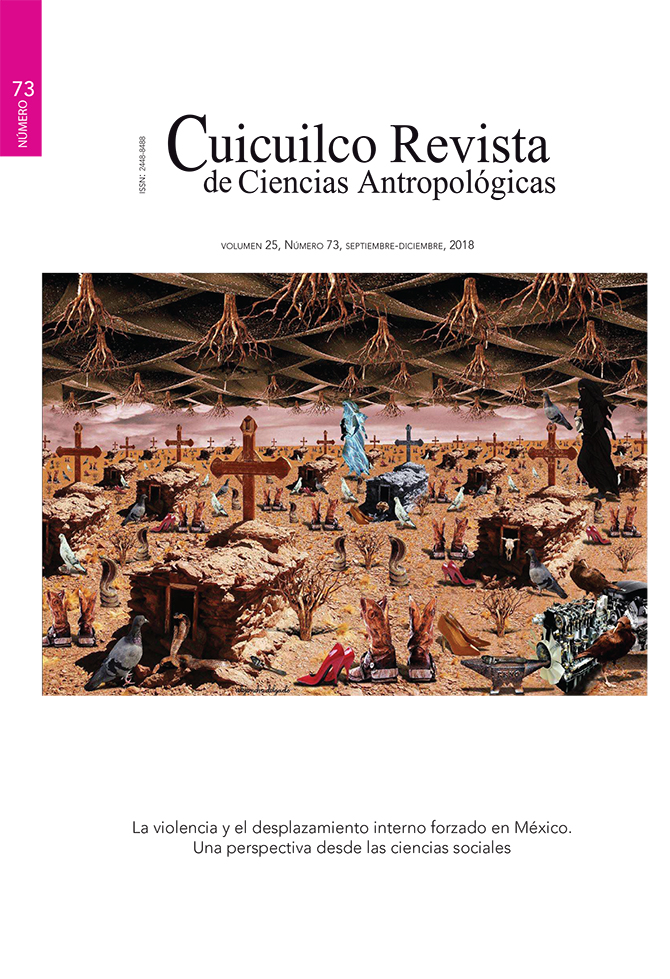Publicado 2019-04-15
Palabras clave
- Antropología, interdisciplinaridad, memorias, afrodescendencia, Rugendas
Cómo citar
Resumen
Este artículo interroga cómo se construye la experiencia de la esclavitud y su dimensión memorial dentro de la diáspora afrodescendiente mediante la figura del barco negrero. Se analizan de manera particular dos intentos, el de un viajero alemán y pintor del siglo XIX, en Brasil (por medio de su visión plasmada en una litografía intitulada “El mercado de esclavos”) y el de los afrodescendientes de la Costa Chica de México (mediante sus narrativas que buscan ubicar el origen de sí mismos). Basándonos en un trabajo de investigación antropológica llevado a cabo en estas comunidades y en el análisis de una pieza pictórica de Johann Moritz Rugendas, del siglo XIX en Brasil, quisimos mostrar el papel emblemático de la figura del barco en los relatos
memoriales sobre el origen y cómo expresa el particular sentido de identidad entre las comunidades afrodescendientes de Latinoamérica. El barco (sea negrero o no) parece establecer una poderosa forma de identificación y aparece, así, como una forma memorial transnacional.
Descargas
Referencias
- Agudelo, Carlos, Capucine Boidin y Livio Sansone (coords.)
- Autour de l’Atlantique Noir, une polyphonie de perspectives. Institut des Hautes Études en Amérique Latine. París.
- Aguirre Beltrán, Gonzalo
- Cuijla. Esbozo etnográfico de un pueblo negro. Fondo de Cultura Económica. México.
- Antón Sánchez, Jhon
- El proceso organizativo afroecuatoriano 1979-2009. flacso. Quito.
- Ballesteros Páez, María Dolores
- Los “otros” mexicanos. Las representaciones visuales de la población de origen africano de México en la pintura costumbrista europea, en Representaciones y prácticas sociales. Visiones desde la historia moderna y contemporánea, Rodrigo Laguarda (coord.). Cuadernos de Trabajo de Posgrado. Instituto Mora. México: 11-54.
- Bastide, Roger
- Mémoire collective et sociologie de bricolage. L’Année sociologique, 21: 65-108.
- Belting, Hans
- Antropología de la imagen. Katz Editores. Buenos Aires.
- Bonhomme, Julien
- Les tribulations de l’esprit blanc (et de ses marchandises). Cahiers d’études africaines (183). <http://etudesafricaines.revues.org/6012>. Consultado el
- de mayo de 2014.
- Burke, Peter
- Visto y no visto. El uso de la imagen como documento histórico. Bolsillo. Barcelona.
- Equiano, Olaudah
- Ma véridique histoire: Africain, esclave en Amérique, homme libre. Mercure. París.
- Gilroy, Paul
- L’Atlantique Noire: Modernité et double conscience. Éditions Amsterdam. París.
- Glissant, Edouard
- Poétique de la relation. Gallimard. París.
- Gutiérrez Avila, Miguel Ángel
- La conjura de los negros: cuentos de la tradición oral afromestiza de la Costa Chica de Guerrero y Oaxaca. Universidad Autónoma de Guerrero, Instituto de Investigación Científica.
- Hall, Stuart
- Identités et cultures. Politiques des Cultural Studies. Éditions Amsterdam. París.
- Hernández Serrano, Frederico
- Juan Moritz Rugendas y su colección de pinturas costumbristas. Anales del Instituto Nacional de Antropología e Historia: 463-472.
- Hochschild, Adam
- Les fantômes du roi Léopold II: un holocauste oublié. Belfond. París.
- Mailhe, Alejandra
- Les limites du visible: réflexions sur la représentation picturale de l’esclavage dans l’oeuvre de Rugendas et de Debret. Conserveries mémorielles 3. Consultado el 10 de enero de 2013.
- Merlet, Annie
- Légendes et histoire des Myéné de l’Ogooué. Libreville, Sépia. ccf y París.
- Motta Sánchez, Jesús Arturo
- Población negra y sus orígenes en el estado de Oaxaca. Siglos XVI y XVII, en Pautas de convivencia étnica en la América Latina colonial (indios, negros, pardos y esclavos), Juan Manuel de la Serna (coord.). UNAM/Universidad de Guanajuato. México: 187-246.
- Paranhos Da Silva, Mauricio
- Jean Maurice Rugendas (1802-1858) et le Brésil. Bulletin de la Société Suisse des Américanistes, 17: 6-10.
- Porras Gallardo, Viviana
- Rugendas, artista viajero y su aporte a la construcción de la representación indígena. Tiempo Histórico, 4: 67-86.
- Rediker, Markus
- A bord du négrier. Une histoire atlantique de la traite. Seuil. París.
- Saillant, Francine
- Le navire négrier. Refiguration identitaire et esclavage au Brésil. Ethnologies, 31 (2): 69-97.
- Savoia, Rafael
- El Negro Alonso de Illescas y sus descendientes (1553-1837, en El Negro en la historia del Ecuador y del sur de Colombia, Rafael Savoira (coord.). Centro Cultural Afroecuatoriano. Quito: 29-62.

